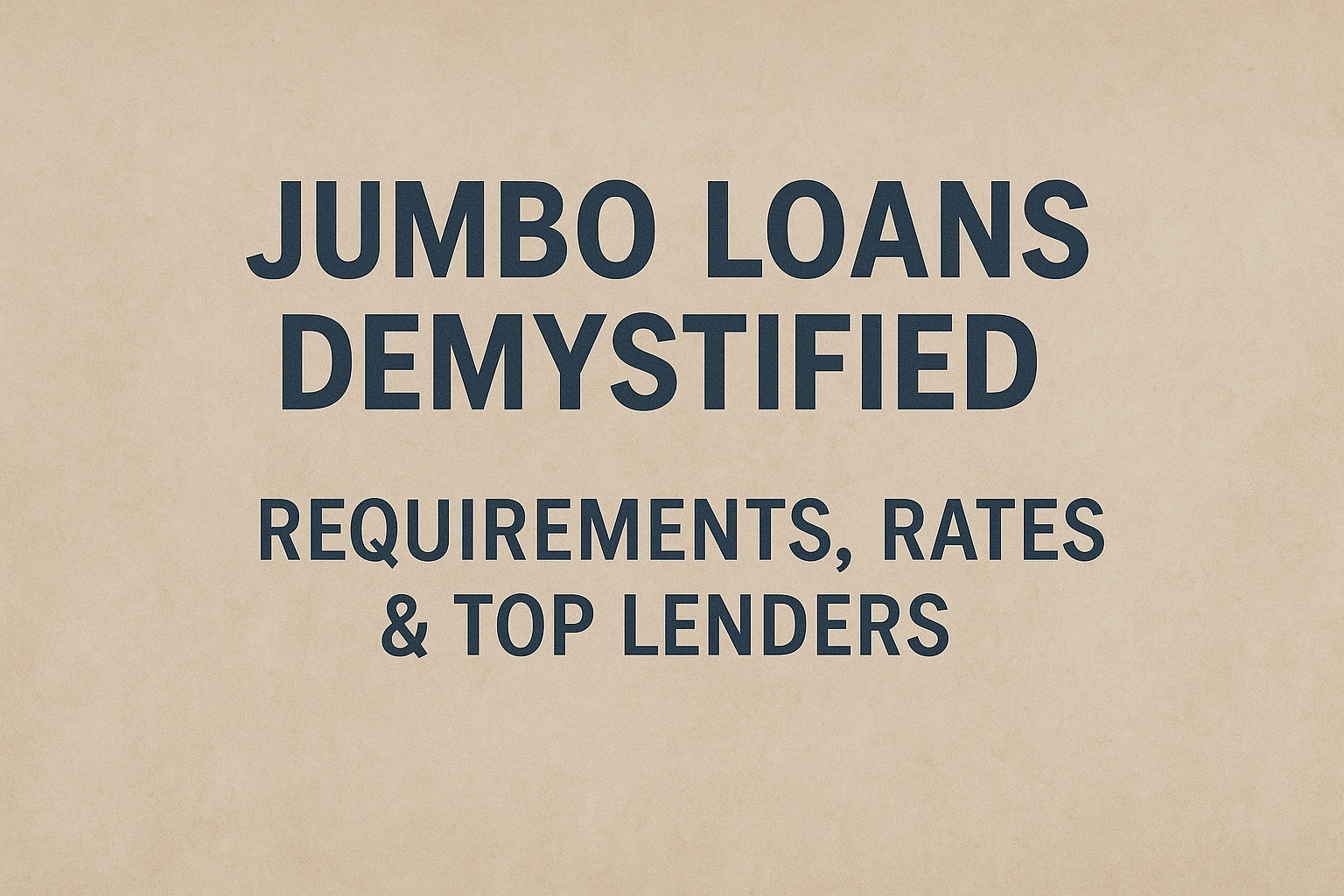When you’re shopping for a home in a high-cost market—be it New York City, San Francisco, London, or Monaco—you may quickly exceed the conforming loan limits set by government-sponsored enterprises (GSEs) like Fannie Mae and Freddie Mac. That’s where jumbo loans come in. Jumbo loans are mortgage products designed for amounts above the conforming limit, allowing borrowers to finance luxury properties, multi-unit dwellings, or expensive coastal homes. However, because they carry greater risk for lenders, jumbo loans come with distinct underwriting criteria, potentially higher interest rates, and stricter documentation requirements.
In this comprehensive guide, you’ll learn everything you need to know about jumbo loans, including:
- What defines a jumbo loan and how limits vary by region
- Common eligibility requirements: credit score, debt-to-income ratios, reserves
- Rate structures: fixed, adjustable, interest-only, and hybrid options
- Comparison of interest rates and costs versus conforming loans
- Profiles of top jumbo loan lenders in major markets
- Pros and cons of using a jumbo mortgage
- Step-by-step application process from prequalification to closing
- Advanced strategies for negotiating rates and terms
- Tax considerations and potential deductibility
- Real-world case studies illustrating borrower scenarios
- Frequently asked questions (FAQs)
With detailed examples and actionable insights, you’ll be armed to secure the best jumbo loan for your luxury home purchase.
What Is a Jumbo Loan?
A jumbo loan, also known as a non-conforming loan, exceeds the maximum balance that GSEs will purchase or guarantee. In 2025, the baseline conforming limit for a single-family home is $726,200 in most U.S. counties, but it can rise to $1,089,300 in high-cost areas. Any mortgage above these thresholds is classified as jumbo.
Why the Limit Matters
Conforming loans carry the implicit guarantee of Fannie Mae or Freddie Mac, which lowers lender risk and often results in lower interest rates and easier qualifications. Jumbo loans lack this guarantee, so banks and mortgage companies impose stricter requirements to mitigate their risk exposure.
Regional Variations
- High-Cost Areas: Conforming limits adjust annually based on local home price trends.
- Luxury Markets: In metros like Los Angeles County, Seattle, and Manhattan, typical home prices far exceed conforming limits, making jumbo loans the norm.
Understanding local conforming limits is the first step in determining whether you need a jumbo mortgage.
Common Eligibility Requirements
Because jumbo loans represent a higher risk, underwriters apply more rigorous standards. Here are the most critical eligibility factors:
1. Credit Score
- Minimums: While conforming loans may allow scores as low as 620, jumbo lenders usually require a minimum of 700–720. Top-tier pricing often begins at 740 or higher.
- Impact on Rates: Each 20-point credit score improvement can lower your interest rate by approximately 0.125%–0.25%.
2. Debt-to-Income (DTI) Ratio
- Front-End Ratio: Housing costs (principal, interest, taxes, insurance) divided by gross monthly income. Lenders typically cap this at 28%–30%.
- Back-End Ratio: Total debt obligations divided by gross income, often limited to 36%–43%.
3. Cash Reserves
- Requirement: Many lenders mandate six to 12 months of mortgage payments in reserves after closing.
- Source of Funds: Reserves can include savings, brokerage accounts, retirement accounts (subject to seasoning requirements), and certain gift funds.
4. Down Payment
- Typical Size: While conforming loans may allow as little as 3% down, jumbo loans often require at least 20%–25% down to qualify. Lower down payments may incur mortgage insurance or higher pricing.
5. Property Appraisal
- Full Appraisal: Lenders will order a comprehensive appraisal to verify current market value, often requiring multiple comparable sales in the vicinity of similar high-end properties.
6. Documentation
- Income Verification: Two years of W-2s, tax returns, profit-and-loss statements for self-employed borrowers, and additional asset statements.
- Employment History: Stable employment or business ownership history, typically two years at a consistent income level.
Meeting these criteria is nonnegotiable for jumbo financing; failing to satisfy any one factor can derail approval.
Interest Rate Structures and Options
Jumbo loans offer a range of rate structures, each with its own risk profile and cost implications:
Fixed-Rate Jumbo Mortgages
- Description: A stable interest rate for the entire term, commonly 15, 20, or 30 years.
- Use Case: Ideal for borrowers seeking predictable payments and long-term stability.
- Rate Premium: Typically priced 0.125%–0.375% above comparable conforming rates.
Adjustable-Rate Jumbo Mortgages (ARJMs)
- Description: An initial fixed period (3/1, 5/1, 7/1, 10/1) followed by annual adjustments tied to an index plus a margin.
- Caps: Initial adjustment cap (e.g., 2%), periodic cap (2%), lifetime cap (5%).
- Use Case: Best for borrowers who plan to sell or refinance before adjustments begin.
Interest-Only Jumbo Loans
- Description: Allows interest-only payments for the first 5–10 years, followed by a fully amortizing period.
- Advantages: Lower initial payments; enhanced cash flow for investors or those expecting income growth.
- Risks: No principal reduction during interest-only period; payment shock when amortization starts.
Hybrid Products and Balloon Mortgages
- Hybrid ARMs: Combines interest-only features with adjustable-rate periods.
- Balloon Mortgages: Short-term fixed rate (e.g., 7 years) with a lump-sum balloon payment due at maturity; often convertible to permanent financing.
Choosing the right structure depends on your ownership timeline, income trajectory, and risk tolerance.
Rate Comparison: Jumbo vs Conforming Loans
To illustrate cost differences, consider a €1,200,000 loan amount in a high-cost market where conforming caps at €726,200. You need a €1,200,000 jumbo loan.
| Loan Type | Rate (%) | Term | Monthly PI Payment (€) |
|---|---|---|---|
| Conforming Cap (€726,200) | 4.00 | 30-year | 3,464 |
| Jumbo (€1,200,000) | 4.25 | 30-year | 5,905 |
| Jumbo Adjustable 5/1 | 3.75 initial | 30-year | 5,557 |
- Rate Spread: Jumbo fixed at 4.25% vs conforming at 4.00% means a 0.25% premium.
- Cost Impact: Over 30 years, the jumbo fixed borrower pays roughly €854,000 in PI versus €612,000 for the conforming cap.
Consider refinancing or down payment strategies to reduce reliance on higher-cost jumbo financing.
Top Jumbo Loan Lenders
Here are some prominent lenders known for competitive jumbo mortgage offerings:
- Chase Bank
- Fixed and adjustable jumbo products, up to €10 million.
- Pricing discounts for existing Chase customers.
- Wells Fargo
- Offers interest-only and hybrid jumbo ARMs.
- Dedicated jumbo mortgage specialists.
- Bank of America
- Flexible down payment options down to 20%.
- Preferred rewards discounts for higher deposit balances.
- Quicken Loans (Rocket Mortgage)
- Fully digital application and rate lock features.
- Streamlined process with soft credit pulls.
- Citibank
- Jumbo interest-only and balloon mortgages.
- Wealth management integration for high-net-worth clients.
Always compare personalized rate quotes and terms from multiple lenders to find the best fit.
Pros and Cons of Jumbo Loans
Pros
- Enables purchase of high-value properties that exceed conforming limits.
- Flexible product offerings: fixed, adjustable, interest-only.
- Potential tax benefits on mortgage interest.
Cons
- Higher interest rates and rate premiums.
- Stricter credit and documentation requirements.
- Larger down payment and reserve requirements.
Understanding these trade-offs helps you decide whether the added cost is justified by your property goals.
Step-by-Step Application Process
- Assess Conforming Limits: Verify whether your target loan amount exceeds local limits.
- Review Financial Profile: Check credit scores, DTI ratios, and liquid reserves.
- Gather Documentation: Collect W-2s, tax returns, bank statements, and proof of assets.
- Obtain Preapproval: Submit applications to multiple lenders to compare rates and loan estimates.
- Select Loan Product: Choose fixed, adjustable, or interest-only based on your strategy.
- Property Appraisal: Lender orders appraisal to confirm market value.
- Underwriting and Approval: Underwriters verify documents, run automated and manual reviews.
- Rate Lock: Secure your interest rate, typically for 30–60 days.
- Closing Disclosure: Review final terms, fees, and payments three days before closing.
- Closing Day: Sign loan documents, pay closing costs, and fund the mortgage.
Completing each step carefully reduces delays and ensures a smooth path to ownership.
Advanced Strategies for Jumbo Borrowers
- Piggyback Loans: Combine a first mortgage at conforming limits with a second lien for the remainder to avoid a single jumbo loan.
- Portfolio Lenders: Use community banks that hold loans on their books, offering more flexibility on terms and overlays.
- Rate Buys: Pay discount points to lower your jumbo loan rate, especially if you plan to hold long term.
- Bridge Financing: Use short-term bridge loans during the purchase before selling an existing property to fund a down payment.
Applying these tactics can yield meaningful savings and increase approval odds.
Tax Considerations
Jumbo mortgage interest is generally deductible when used to acquire or improve your primary or secondary residence, subject to tax code limits. Consult a tax professional regarding:
- Interest Deduction Caps: Under current U.S. law, interest on up to $750,000 of mortgage debt is deductible for married couples filing jointly ($375,000 if married filing separately).
- Home Equity Debt: Interest on home equity used for substantial improvements remains deductible; consult local regulations outside the U.S.
Staying abreast of tax law changes ensures you maximize potential benefits.
Case Studies
Case Study A: Executive Relocating to Monaco
- Scenario: €5 million property requiring €4 million financing.
- Solution: €750,000 conforming loan; €3.25 million jumbo financing with a 5/1 ARM.
- Outcome: Lower initial rate during relocation; sold within four years before adjustments.
Case Study B: Multi-Unit Investment Property in Manhattan
- Scenario: €3.8 million apartment building.
- Solution: Interest-only jumbo loan with five-year interest-only period, then 25-year amortization.
- Outcome: Maximized cash flow during lease-up; principal paydown begins after vacancy stabilized.
Frequently Asked Questions (FAQs)
Q1: What is the difference between a jumbo and non-jumbo loan?
Jumbo loans exceed conforming loan limits; non-jumbo (conforming) loans fall at or below those limits and are eligible for GSE purchase.
Q2: Can I get a jumbo loan with less than 20% down?
Some lenders offer lower down payment options, but they may require mortgage insurance or pay higher rates.
Q3: Are jumbo loan rates always higher than conforming rates?
Generally yes, but in periods of tight financial conditions or for highly qualified borrowers, the spread can narrow to near zero.
Q4: How long does a jumbo loan application take?
Typically 30–45 days, depending on documentation completeness and appraisal scheduling.
Q5: Can I refinance a jumbo loan later?
Yes. Refinancing options exist to convert ARMs to fixed rates, switch terms, or take cash out, subject to current landing page policies
Jumbo loans unlock the door to luxury and high-cost properties that standard mortgages cannot finance. While they carry higher rates, stricter criteria, and larger down payments, understanding eligibility requirements, rate structures, and lender offerings empowers you to make an informed choice. By following the step-by-step process, leveraging advanced strategies, and comparing multiple lenders, you can secure jumbo financing that aligns with your investment goals and risk tolerance.








